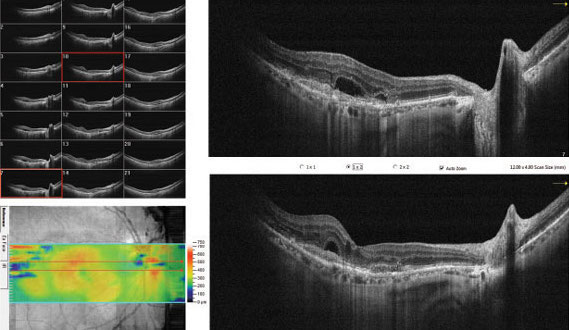 |
Patients who have fluctuating retinal thickness values during treatment may be more likely to have a negative response to anti-VEGF. Photo: Steven Ferrucci, OD. Click image to enlarge. |
In an effort to evaluate the correlation between variability in central foveal thickness (CFT) and vision with ranibizumab in a HARBOR post-hoc analysis, researchers recently found that fluctuations in retinal thickening may be associated with treatment response in patients with neovascular age-related macular degeneration (nAMD) taking ranibizumab.
A total of 1,097 patients with nAMD received monthly or as-needed (PRN) ranibizumab (0.5mg or 2.0mg) for 24 months. Fluctuation scores were used to assess CFT variability, with a change <50μm considered clinically insignificant. Fluctuation scores were grouped into four categories and change in best-corrected visual acuity (BCVA) was plotted against fluctuation score for CFT, subretinal fluid height, neurosensory retina and neurosensory retina/subretinal hyperreflective material.
Patients with lower fluctuations scores had the greatest vision gains at month 24, with changes from baseline of 9.0 to 10.8 and 8.7 to 10.6 letters in the monthly and PRN arms, respectively. Corresponding changes for high fluctuation patients were 6.7 and 6.5 letters, respectively. There were no differences between groups for association between fluctuations in subretinal fluid height and BCVA gains. There were inverse correlations between magnitude of fluctuations in neurosensory and inner retina thickness and BCVA gains for the high fluctuation group vs. the others. Patients with more anatomical stability showed rapid, robust BCVA gains, whereas those characterized by variability had lesser responses.
“Fluctuations in retinal thickness during anti-VEGF treatment may be associated with treatment response,” the study authors concluded in their paper. “Patients with the greatest fluctuation scores may still be able to attain vision gains, although less than those among patients with the lowest fluctuation scores, if they receive consistent treatment. Monitoring fluctuations in retinal thickness during treatment may help prognosticate treatment response.”
Sheth V, D’Rozario M, Gune S, Blotner S. Fluctuations in central foveal thickness and association with vision outcomes with anti-VEGF therapy for nAMD: HARBOR post hoc analysis. BMJ Open Ophthalmol. March 9 , 2022. [Epub ahead of print]. |


